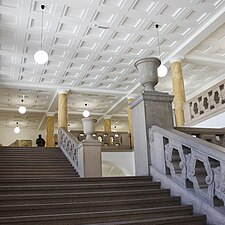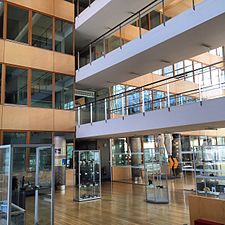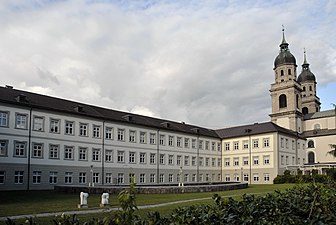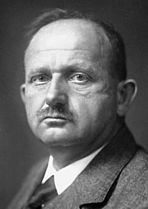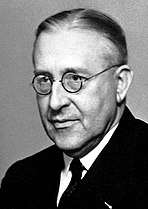University of Innsbruck
| University of Innsbruck | |
|---|---|

|
|
| founding | October 15, 1669 |
| Sponsorship | state |
| place | Innsbruck , Tyrol , Austria |
| Rector | Tilmann Märk |
| Students | 27,095 (as of May 2020)
|
| Employee | 5,101, including 3,580 research assistants (as of May 2020) |
| including professors | 269, of which 69 women (as of May 2020) |
| Annual budget | 308.4 million euros (as of May 2020)
- Global budget: 249.9 million euros |
| Website | www.uibk.ac.at |
The Leopold-Franzens-Universität Innsbruck ( LFU or LFUI for short , Latin Universitas Leopoldino-Franciscea Oenipontana ), founded in 1669, is the largest educational and research institution in western Austria and the most important university in Austria after Vienna . It is considered the state university of the Austrian federal states of Tyrol and Vorarlberg . Historically, she also performed this function for South Tyrol , Welschtirol (Trentino), Liechtenstein and Luxembourg , but this is no longer the case today due to the establishment of their own universities in these countries. Measured by the number of students, it is Tyrol's largest educational institution before Trento and Bolzano .
history
In 1562 the Jesuits built a grammar school in Innsbruck . Financed by a special tax on the Haller Salz, a full university with four faculties was founded on October 15, 1669 by Emperor Leopold I , including the law faculty in 1671/72 and the medical faculty in 1674/75. On November 29, 1781 Joseph II. Back to a lyceum reduced, took place in 1826, the restoration of the University of Innsbruck by Emperor Francis I . In honor of both founding fathers, the University of Innsbruck is called Leopold-Franzens-University Innsbruck .
At the time of National Socialism it was established in March 1941 by then-rector Raymond of Klebelsberg in German Alps University renamed. As in all universities, there were “cleanups”. Opponents of the National Socialists were disempowered and excluded from scientific operations. In 1945 it was reopened under the name of Innsbruck University after the end of World War II .
The second half of the 20th century brought further expansion steps at the university: in 1969 the Faculty of Civil Engineering and Architecture and in 1976 the Faculty of Humanities and Social and Economic Sciences, which emerged from the law and political sciences. The Faculty of Medicine was spun off in 2004 and the School of Education was founded in 2012 , which was renamed the Faculty of Teacher Education in 2018.
Position in Austria and Europe
Since 2011, the University of Innsbruck has been ranked in the Times Higher Education Rankings as the second best university in Austria after Vienna in places 201–225 (not broken down further). In the partial evaluation "International Outlook" published since 2013 to record the most internationally oriented universities in the world, the University of Innsbruck ranks seventh worldwide. The evaluation is based on an assessment system in which research, teaching and the international reputation of the universities are assessed in particular. The evaluation of the international visibility of the research results is particularly positive. In the QS World University Rankings (QS Ranking) it is regularly in the ranks between 260 and 280. In the Shanghai ranking , it ranks as the second best Austrian university in the ranks between 201 and 300. The Handelsblatt Ranking 2015 includes the business administration faculty the 15 best business administration faculties in German-speaking countries.
The university ranking U-Multirank , initiated by the EU , does not create any rankings, but makes the universities comparable using 34 different indicators. Here the University of Innsbruck is one of the Austrian universities with the highest grades. In the Leiden ranking, which is based on bibliometric data, the Leopold-Franzens-University does particularly well in the "Collaboration indicators". Measured by the number of publications that were written with foreign partners, the University of Innsbruck will be ranked 12th worldwide in 2020 and shows the high level of international networking.
The University of Innsbruck has been a member of the Aurora research network since 2019 and cooperates with various universities from Germany, Spain and the Netherlands. As part of the "Africa-UniNet" research network, research projects are carried out with the most research-intensive African universities. Furthermore, the University of Innsbruck is one of several European universities and research institutions that cooperate with the IBM quantum computer network.
organization
Faculties
- Faculty of Architecture ,
- Faculty of Business Administration ,
- Faculty of Education ,
- Faculty of Biology ,
- Faculty of Chemistry and Pharmacy ,
- Faculty of Earth and Atmospheric Sciences ,
- Faculty of Mathematics , Computer Science and Physics ,
- Faculty of Social and Political Sciences,
- Faculty of Psychology and Sports Science ,
- Faculty of Technical Sciences (formerly Faculty of Civil Engineering),
- Faculty of Economics and Statistics ,
- Catholic Theological Faculty,
- Faculty of Philological and Cultural Studies,
- Faculty of Philosophy and History,
- Faculty of Law,
- Faculty of Teacher Education (formerly called "School of Education" until February 2018).
The originally six faculties were divided into 15 faculties in 2004. In 2012 the School of Education was established as the 16th faculty; this step served as the basis for the further expansion of teacher training.
As part of the implementation of the University Act 2002 , the former medical faculty was spun off as Innsbruck Medical University in 2004 . Since then, the University of Innsbruck is no longer a full university in the traditional sense. Since this separation came about against the will of the faculty, the reintegration is discussed again and again.
The university is a member of the Alliance of Sustainable Universities , which was founded in 2012 with the aim of promoting sustainability at universities.
- Photo gallery: University of Innsbruck
Locations
The buildings of the University of Innsbruck are spread over the city area, so it is not a “ campus university”.
- Campus Innrain : The main building, opened in 1924, is the seat of the rectorate and the law faculty. The adjacent new building opened in 1981 with the Geiwi Tower , the Bruno Sander House and the Josef Möller House houses institutes of the humanities, natural sciences and law. The main location of the university library is also located here .
- Campus Universitätsstraße: The former Jesuit grammar school and the adjoining building next to the Jesuit Church, which has been used as a university since 1766, are now used by the Catholic Theological Faculty. Opposite, the Faculty of Social and Economic Sciences opened in 1997 on the site of the former Fenner barracks.
- Campus Technology: A large building complex was built in 1969 in the Hötting West district , which today houses numerous scientific institutes as well as architecture, technology and IT.
- Campus Sports: At Innsbruck Airport , the Sport Institute and the University Sports Center are housed.
- Center for Chemistry and Biomedicine: In 2012 the building shared by the Innsbruck universities was opened on the Innrain. It houses chemical, pharmaceutical and biomedical facilities of the two Innsbruck universities.
- Center for Ancient Cultures: The archaeological and ancient studies institutes have been housed in the atrium on Langen Weg since 2008. There is also the specialist library and part of the Innsbruck Archaeological Museum.
- Botany: The Institute of Botany and parts of the Institute of Ecology are located at the University's Botanical Garden in the Hötting district. The old university observatory built in 1904 is also located there .
- Musicology: The Institute for Musicology has been based at the Haus der Musik Innsbruck since 2018 .
- Numerous other facilities are spread across the city. Branch offices are the Research Institute for Textile Chemistry and Textile Physics in Dornbirn , Vorarlberg and the Research Institute for Limnology in Mondsee , Upper Austria, which was taken over by the Austrian Academy of Sciences in 2012 . Further teaching and research facilities are spread across Tyrol, for example the university center in Obergurgl .
University management
The University of Innsbruck is a public corporation with the right of self-administration. The university is run by a rectorate. He is supported by the University Council and the Senate.
Rectorate:
- Tilmann Märk , Rector
- Bernhard Fügenschuh , Vice Rector for Teaching and Students
- Wolfgang Streicher, Vice Rector for Infrastructure
- Anna Buchheim, Vice Rector for Human Resources
- Ulrike Tanzer , Vice Rector for Research
University Council
- Werner Ritter (Chairman)
- Henrietta Egerth-Stadlhuber (Deputy Chair)
- Luise Müller
- Johannes Ortner
- Anton Pelinka
- Carina Schiestl-Swarovski
- Karin Treichl
Senate: The Senate consists of 26 people: 13 representatives belong to the curia of university professors, 6 to the curia of university lecturers and academic staff in research and teaching, one mandate represents general university staff , and six students represent the student body. Senate chairman was Christian Smekal from 2003 to 2005 and Ivo Hajnal from 2005 to 2019 . In October 2019, Walter Obwexer was elected to succeed Ivo Hajnal as Chairman of the Senate for the term of office until September 2022, Walter-Michael Grömmer remained his deputy .
Education
The University of Innsbruck offers 41 bachelor programs including teacher training programs, 56 master’s programs, 4 diploma programs and 27 PhD / doctoral programs (as of the 2015/16 academic year) in the fields of architecture, humanities, natural sciences, law, social and economic sciences as well as theology and technical sciences.
Special admission regulations apply before general admission to the Bachelor's degree in Architecture, Biology, Computer Science, Pharmacy, Psychology, Economics, Teacher Training, the Diploma in International Economics and the Master's in Psychology.
Personalities
Nobel Prize Winner
- Fritz Pregl (chemistry 1923)
- Adolf Windaus (chemistry 1928)
- Hans Fischer (chemistry 1930)
- Victor Franz Hess (Physics 1936)
- Eugen Böhm von Bawerk (Political Economy)
- Erika Cremer (physical chemistry)
- Albert Defant (meteorologist and oceanographer)
- Heinrich von Ficker (meteorologist and geophysicist)
- Julius von Ficker (General History and Rector)
- Franz Fliri (climatologist)
- Nikolaus Grass (legal history)
- Wolfgang Gröbner (Mathematics)
- Franz Xaver Holl (Canon Law)
- Josef Andreas Jungmann (Pastoral Theology)
- Karl Heider (Zoology)
- Anton Kerner von Marilaun (botany)
- Hans Klecatsky (Public Law, Austrian Federal Minister)
- Josef Lackner (architect) (architecture)
- Heinrich Lammasch (criminal law, legal philosophy and international law; Austrian Prime Minister)
- Arthur March (physics)
- Anton Pelinka (Political Science)
- Herlinde Pissarek-Hudelist (Religious Education )
- Kleophas Pleyer (story)
- Hugo Rahner (history of dogma and patrology)
- Karl Rahner (dogma story)
- Bruno Sander (geologist)
- Egon Schweidler (experimental physics, rector)
- Jayandra Soni (Indologist)
- Rolf Steininger (contemporary history)
- Karlheinz Töchterle (Classical Philology; Austrian Federal Minister; Rector)
- Alexander Van der Bellen (economics, Austrian member of the National Council, ninth Austrian Federal President)
- Leopold Vietoris (mathematics)
- Wilhelm Wirtinger (mathematics)
- Anton Zeilinger (experimental physics)
Alumni
- Günther Andergassen (1930–2016), composer, political activist ( BAS )
- Friedrich Bertlwieser (* 1952), agricultural scientist and book author
- Reinhold Bilgeri (* 1950), musician, writer and filmmaker
- Günther Bonn (* 1954), chemist
- Bruno Buchberger (* 1942), mathematician
- Nicetas Budka (1877–1949), Ukrainian bishop
- Norbert Burger (1929–1992), Austrian politician ( NDP / BAS )
- Wolfgang Dietrich (* 1956), peace researcher and political scientist
- Gerhard Fittkau (1912-2004), theologian
- Christine Fleck-Bohaumilitzky (* 1955), theologian
- Helmut Freudenschuss (* 1956), diplomat
- Alfred Gebauer (1909–2005), internist and radiologist
- Hans-Peter Glanzer (* 1960), diplomat
- Harry Glück (1925–2016), architect
- Walter Guggenberger (* 1947), politician ( SPÖ )
- Hans Heiss (* 1952), historian and regional politician ( Verdi Grüne Vërc )
- Hubert Heiss (* 1955), diplomat
- Friedrich August von der Heydte (1907–1994), lawyer, officer and politician
- Andreas Khol (* 1941), politician ( ÖVP )
- Johannes Kleinhappl (1893–1979), Catholic priest and moral theologian
- Grigorios Larentzakis (* 1942), Orthodox theologian
- Auguste Lechner (1905–2000), writer
- Wolfgang Lechner (* 1953), journalist
- Eva Lichtenberger (* 1954), politician ( The Greens )
- Andreas Maislinger (* 1955), historian and political scientist
- Herbert Mandl (* 1961), alpine ski trainer
- Renate Müssner (* 1957), politician and member of the government of the Principality of Liechtenstein
- Alois Negrelli von Moldelbe (1799–1858), Austrian engineer and pioneer of transport engineering
- Aloys Oberhammer (1900-1983); Austrian politician
- Julius Perathoner (1849–1926), Mayor of Bolzano (1895–1922), member of the Reichsrat and Landtag
- Bruno Platter (* 1944), 65th Grand Master of the Teutonic Order
- Franz Posch (* 1953), folk musician
- Peter Paul Rainer (* 1967), historian and former South Tyrolean regional politician ( SVP / F )
- Benedikt Sauer , (* 1960), journalist and non-fiction author
- Barbara Rett (* 1953), cultural journalist
- Robert Rollinger (* 1964), ancient orientalist and ancient historian
- Philipp von Schoeller (1921–2008), economic functionary and honorary member of the IOC
- Ivo Sanader (* 1953), former Croatian Prime Minister
- Herbert Sausgruber (* 1946), former Governor of Vorarlberg (ÖVP)
- Hanns Martin Schleyer (1915–1977), 1938 head of the NS student union , German economic functionary
- Jossyf Slipyj (1892–1984), Archbishop of Lemberg
- Josef Steiner (* 1945), theologian
- Otto Stolz (1842–1905), mathematician
- Moritz Thomann (1722–1805), doctor and Jesuit missionary in India and Africa
- Alexander Van der Bellen (* 1944), 9th Federal President of the 2nd Republic
- Herwig van Staa (* 1942), former Tyrolean governor (ÖVP)
- Theodor von der Wense (1904–1977), physician and former rector of the University of Innsbruck
- Clemens August Graf von Galen (1878–1946), cardinal
- Markus Wallner (* 1967), Governor of Vorarlberg (ÖVP)
- Michael Weninger (* 1951), diplomat and Roman Catholic priest
- Armin Wolf (* 1966), journalist
- Karl Zeller (* 1961), constitutional lawyer, politician (SVP)
- Bernhard Zimburg (* 1954), ambassador
Rectors
- from 1637: Johann Baptist Cysat
- 1692, 1696 and 1702: Sigismund Epp
- around 1695: Johann Christoph Frölich von Frölichsburg
- around 1716 to 1740: Franz Carl Anton Egloff
- 1743 to 1744: Peter Anton Inama
- 1800 to 1801: Joseph Stapf
- from 1848: Josef Georg Böhm
- from 1858: Ernst von Moy de Sons
- 1859 to 1860: Julius von Ficker
- 1883/84: Paul Steinlechner
- 1889 to 1890: Johannes Müller (philologist)
- 1897 to 1898: Franz von Wieser
- 1898 to 1899: Friedrich Stolz
- 1906 to 1907: Ernst Hruza
- 1907 to 1908: Rudolf von Scala
- 1912 to 1913: Paul Gustav Kretschmar
- 1915 to 1916: Walther Hörmann von Hörbach
- 1922: Hermann von Schullern zu Schrattenhofen
- 1922 to 1923: Josef Schatz
- 1923 to 1924: Hans von Haberer
- 1924: Theodor Rittler
- 1927/28: Adolf Günther
- 1928 and 1929: Hermann Wopfner
- 1929 to 1930: Richard Seefelder
- 1933 to 1934: Raimund von Klebelsberg
- 1937/38: Karl Brunner
- 1938 to 1942: Harold Steinacker
- 1942 to 1945: Raimund von Klebelsberg
- 1945/46: Karl Brunner
- 1949 to 1950: Hugo Rahner
- 1950/51: Albert Defant
- 1951: Eduard Reut-Nicolussi
- 1952 to 1953: Burghard Breitner
- 1953/54: Josef Andreas Jungmann
- from 1955: Arnold Herdlitczka
- 1958 to 1959: Hans Kinzl
- 1962/63: Franz Hampl
- 1967 to 1968: Ernst Kolb
- 1968: Theodor von der Wense
- 1969 to 1971: Emerich Coreth
- 1970 to 1971: Josef Kolb
- 1971 to 1975:
- 1975 to 1977: Otto Muck
- 1977 to 1979: Franz Fliri
- 1979 to 1981: Herbert Braunsteiner (1923-2006)
- 1981 to 1983: Clemens August Andreae
- 1983 to 1985: Josef Rothleitner (1934–2011)
- 1985 to 1987: Wolfram Krömer
- 1987 to 1991: Rainer Sprung (1936–2008)
- 1991 to 1995: Hans Moser
- 1995 to 1999: Christian Smekal
- 1999 to 2003: Hans Moser
- 2003 to 2007: Manfried Gantner
- 2007 to 2011: Karlheinz Töchterle
- since 2011: Tilmann Märk
literature
- Margret Friedrich : Regional needs, sovereign planning, exchange of knowledge. University and rooms in the 18th century and the early 19th century using the example of the University of Innsbruck , in: Geschichte und Region / Storia e regione , No. 2/2017, pp. 44–71.
- Margret Friedrich, Dirk Rupnow (ed.): History of the University of Innsbruck 1669−2019 , 2 volumes, Innsbruck University Press, Innsbruck 2019, ISBN 978-3-903187-67-2 .
- Peter Goller , Georg Tidl : jubilation without end. The University of Innsbruck in March 1938. On the Nazification of the Tyrolean State University , Löcker-Verlag, Vienna 2012.
- Franz Huter : The subjects of mathematics, physics and chemistry at the Philosophical Faculty of Innsbruck until 1945 (publications of the University of Innsbruck 66 = research on Innsbruck university history 10), University of Innsbruck, Innsbruck 1971.
- Franz Huter, Gerhard Oberkofler , Peter Goller (edit.): The register of the University of Innsbruck . Multi-volume work, Innsbruck University Press, Innsbruck 1975ff.
- Tilmann Märk (Ed.): Leopold Franzens University Innsbruck. Universitas semper reformanda , innsbruck university press, Innsbruck 2016, ISBN 978-3-903122-03-1 .
- Gerhard Oberkofler: Report on the victims of National Socialism at the University of Innsbruck , in: Zeitgeschichte , Heftsammlung 1980/81 (8th year), pp. 142–149. Available online at ÖNB-ANNO .
- Gerhard Oberkofler, Peter Goller: History of the University of Innsbruck (1669–1945) , Lang-Verlag, Frankfurt a. M./Wien 1996.
- Gerhard Oberkofler: University ceremony . A biotope of the zeitgeist . Passagen Verlag, Vienna 1999.
- Austrian Students' Union (Ed.): Austrian Universities in the 20th Century. Austrofascism, National Socialism and the Consequences , Facultas, Vienna 2013.
- Günther Pallaver , Michael Gehler (eds.): University and Nationalism: Innsbruck 1904 and the storming of the Italian law faculty , Museo Storico del Trentino, Trento 2013.
See also
- alpS - Center for Natural Hazard Management
- Botanical Garden of the University of Innsbruck
- Fatti di Innsbruck
- Brenner Archive Research Institute
- Innsbruck newspaper archive
- Hafelekar measuring station
- University and State Library of Tyrol
- Innsbruck University Observatory
- List of universities in Austria
Web links
- Website of the Leopold Franzens University Innsbruck
- Website of the archive of the University of Innsbruck (contains essays and documents on the history of the University of Innsbruck)
Individual evidence
- ↑ a b c d e 350 - University of Innsbruck in figures 2020
- ↑ Hannes Obermair : Early knowledge. Looking for pre-modern forms of knowledge in Bolzano and Tyrol . In: Hans Karl Peterlini (Ed.): Universitas Est, Vol. I: Essays on the history of education in Tyrol / South Tyrol from the Middle Ages to the Free University of Bozen . Bozen: Bozen / Bolzano University Press 2008. ISBN 978-88-7283-316-2 , pp. 35-87, reference pp. 80-83.
- ↑ Archive “Displaced Science” at the University of Innsbruck , accessed on March 26, 2015
- ↑ Timetables of the University of Innsbruck , accessed on August 19, 2014
- ^ Times Higher Education World University Rankings , accessed March 31, 2015
- ↑ The 100 most international universities in the world 2014 , accessed March 31, 2015
- ^ Melanie Staffner, Barbara Härting: Rankings - University of Innsbruck. Retrieved June 3, 2019 .
- ↑ https://www.tips.at/nachrichten/linz/wirtschaft-politik/509062-weltweites-uni-ranking-jku-hat-sich-um-50-plaetze-verbessert
- ^ University of Innsbruck in the Academic Ranking of World Universities (ARWU) , accessed on March 31, 2015
- ↑ https://www.uibk.ac.at/ipoint/blog/1317853.html
- ^ U-Multirank , accessed March 31, 2015
- ↑ https://www.uibk.ac.at/universitaet/profil/rankings.html.de
- ↑ https://www.mein Bezirk.at/tirol/c-lokales/bildung-bei-universitaetsnetzwerk-aurora_a3753528
- ↑ https://www.uibk.ac.at/newsroom/africa-uninet-neues-forschungsnetzwerk.html.de
- ↑ https://www.tt.com/artikel/15821667/uni-innsbruck-kooperiert-mit-ibm-quantencomputer-netzwerk
- ^ Bulletin of the Leopold Franzens University Innsbruck. In: Bulletin. University of Innsbruck, February 7, 2018, accessed on October 24, 2018 (German).
- ↑ iPoint: School of Education - the "16" , accessed on 2 April 2015
- ↑ iPoint: Innsbruck medical professionals oppose outsourcing , accessed on April 2, 2015
- ^ Töchterle wants to merge Uni and Med-Uni Innsbruck , Die Presse, accessed on April 2, 2015
- ↑ Due to poor planning, the building's glass roof had to be extensively renovated by 2009. The controversial building complex, which also houses the MCI ( Management Center Innsbruck ) as well as apartments and business premises, was planned by henke and schreieck architects from Vienna.
- ↑ The building was planned and built by architekturwerkstatt din a4 .
- ↑ "ATRIUM - Center for Ancient Cultures" , accessed on April 2, 2015
-
^ Archaeological Museum Innsbruck - Collection of casts and originals of the University of Innsbruck ,
Fick Sabine (Ed.): Atriumhaus. The Center for Ancient Cultures (Innsbruck 2009) (PDF; 3.3 MB) - ↑ For example the Institute for Educational Science, the Institute for Psychosocial Intervention and Communication Research and the Archive for Architecture.
- ↑ University of Innsbruck: Rector's team presents program for the coming years. In: www.uibk.ac.at. Retrieved June 9, 2016 .
- ↑ derStandard.at: University councils are almost complete now . Article dated April 30, 2018, accessed May 2, 2018.
- ^ University Council of the University of Innsbruck . Retrieved May 2, 2018.
- ↑ New Senate Chair elected. In: uibk.ac.at. October 11, 2019, accessed October 12, 2019 .
- ↑ University of Innsbruck: Walter Obwexer is the new chairman of the Senate. October 11, 2019, accessed October 12, 2019 .
- ↑ Courses offered by the University of Innsbruck , accessed on February 18, 2016
- ↑ Admission procedure prior to admission , accessed on February 18, 2016
Coordinates: 47 ° 15 ′ 47 " N , 11 ° 23 ′ 2" E




